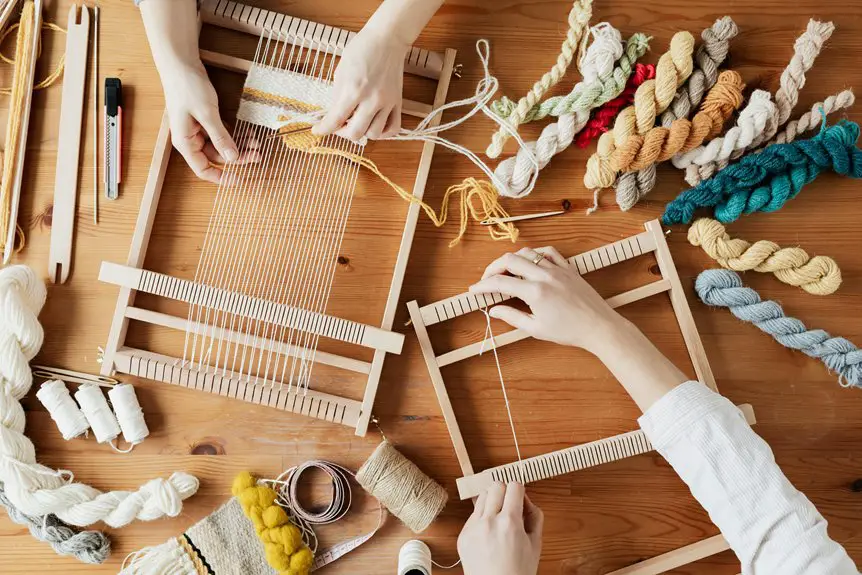Crepe de Chine is a lightweight silk or synthetic fabric known for its slightly crinkled texture and matte finish. You’ll find it’s soft, breathable, and drapes beautifully, making it perfect for elegant blouses, dresses, scarves, and evening wear. Its durable weave holds shape without stiffness, offering comfort with a touch of sophistication. Plus, it’s gentle on your skin and easy to style. Keep exploring to uncover its rich history, care tips, and how it compares to other silks.
Table of Contents
Key Takeaways
- Crepe de Chine is a lightweight silk or synthetic fabric with a tightly twisted yarn plain weave, producing a slightly pebbled, matte surface texture.
- It offers excellent breathability, moisture-wicking, and natural stretch, making it comfortable for extended wear.
- The fabric drapes fluidly yet holds its shape, ideal for elegant blouses, dresses, scarves, and tailored garments.
- Care requires gentle handling: hand wash cold or dry clean, avoid wringing, and iron on low heat with a pressing cloth.
- Compared to charmeuse and habotai silks, crepe de Chine provides a textured, matte elegance favored by top designers for sophisticated fashion.
Origin and History of Crepe De Chine
Although Crepe de Chine is often associated with luxury and elegance today, it actually has a rich history that dates back centuries.
You might be surprised to learn that its origins trace to ancient China, where artisans mastered silk weaving techniques that created fabrics with a distinct crinkled texture.
Over time, this fabric caught the attention of European traders, who brought it to the West during the Silk Road era.
By the early 20th century, Crepe de Chine had become popular in Parisian fashion circles, admired for its lightweight feel and flowing drape.
When you wear or work with this fabric, you’re connecting to a legacy that blends Eastern craftsmanship with Western style, making it both historically significant and timelessly elegant.
Composition and Material Variants
You’ll find Crepe de Chine comes in both silk and synthetic options, each offering unique qualities.
Understanding the blend ratios helps you predict how the fabric will feel and behave.
These material choices directly impact the texture, drape, and durability you experience.
Silk and Synthetic Options
When choosing crepe de chine fabric, you’ll find both silk and synthetic options offer distinct benefits. Silk crepe de chine feels luxurious, drapes beautifully, and breathes well, making it ideal for high-end garments.
Synthetic versions, like polyester, provide durability and affordability, often resisting wrinkles better than silk.
Consider these points when deciding:
- Silk offers a natural sheen and softness but requires delicate care.
- Synthetics are easier to maintain and more budget-friendly.
- Silk crepe de chine excels in comfort for warm weather.
- Synthetic crepe de chine can mimic silk’s appearance with added strength.
Your choice depends on how you balance luxury, care, cost, and performance.
Blend Ratios Explained
Since crepe de chine fabric comes in various compositions, understanding blend ratios helps you choose the right balance of qualities. Whether you prefer pure silk for luxury or blends for durability, the ratio impacts softness, breathability, and care needs. Here’s a quick guide to common blends:
| Blend Ratio | Main Feature | Ideal Use |
|---|---|---|
| 100% Silk | Luxurious, lightweight | Evening wear, scarves |
| 70% Silk / 30% Polyester | Durable, easy care | Daily wear, blouses |
| 50% Silk / 50% Cotton | Breathable, soft | Casual dresses, tops |
| 60% Polyester / 40% Silk | Affordable, wrinkle-resistant | Workwear, uniforms |
| 100% Polyester | Very durable, budget-friendly | Costumes, linings |
Impact on Fabric Texture
Although crepe de chine fabric comes in various compositions, each blend directly influences its texture and feel against your skin.
When you choose crepe de chine, understanding these variations helps you pick the perfect fabric for your needs. Here’s how different materials affect the texture:
- Silk: Offers a smooth, soft touch with a slight sheen and elegant drape.
- Polyester: Feels firmer and more durable but less breathable than silk.
- Cotton Blends: Provide a matte finish with a crisp, lightweight feel ideal for casual wear.
- Rayon: Mimics silk’s softness but can feel cooler and slightly heavier.
Each option changes how crepe de chine feels, so consider your comfort and garment purpose when selecting a blend.
Weave and Texture Details
You’ll notice Crepe de Chine’s unique weave structure gives it a slightly crinkled surface texture that feels soft yet textured.
This lightweight fabric drapes beautifully, making it ideal for elegant garments.
Let’s explore how these qualities come together in its weave and texture.
Weave Structure Overview
When you examine Crepe de Chine fabric closely, its unique weave structure becomes clear. This fabric uses a plain weave with a twist: the threads are tightly twisted before weaving, which sets it apart from other silks.
Here’s what you should know about its weave:
- Plain Weave Foundation: The basic crisscross pattern of warp and weft threads creates a durable base.
- Highly Twisted Yarns: Both warp and weft yarns are twisted, giving the fabric a slightly pebbled surface.
- Balanced Construction: Equal tension on warp and weft guarantees stability and prevents distortion.
- Fine Thread Count: The use of fine, densely packed threads results in a lightweight but strong fabric.
This structure gives Crepe de Chine durability and a fluid drape, making it ideal for elegant garments.
Surface Texture Characteristics
The surface texture of Crepe de Chine stands out due to its distinct pebbled feel created by the tightly twisted yarns in both warp and weft.
This tight twisting causes the fabric to have a slightly rough, granular texture, giving it that signature subtle crinkled appearance.
You’ll notice that this texture isn’t uniform; it has a natural, irregular grain that adds depth and richness.
The plain weave foundation guarantees durability, but it’s the yarn twist that provides the uneven, matte finish you associate with Crepe de Chine.
When you touch it, you’ll feel a gentle springiness, a result of the yarn tension and weave combination.
This unique texture makes Crepe de Chine ideal for elegant garments where surface interest matters without heaviness or stiffness.
Fabric Weight and Drape
Beyond its distinctive texture, Crepe de Chine impresses with a balanced fabric weight that feels light yet substantial in your hand. This makes it versatile for various garment types without being too heavy or flimsy.
Its weave contributes to a graceful drape that flows smoothly, enhancing the garment’s silhouette.
You’ll notice these key aspects when working with Crepe de Chine:
- Medium-light weight offering comfort and elegance
- Fluid drape that moves naturally with your body
- Slightly crinkled texture aiding in wrinkle resistance
- Soft hand feel that maintains shape without stiffness
This combination lets you create pieces that look polished and feel comfortable all day long.
Distinctive Physical Characteristics
Crepe de Chine stands out for its unique texture and lightweight feel, which you’ll notice the moment you touch it.
Crepe de Chine captivates with its distinctive texture and featherlight touch from the very first feel.
The fabric features a slightly crinkled or pebbled surface created by the tight weaving of fine, twisted yarns. This texture gives crepe de Chine a subtle, matte finish that sets it apart from shinier silks.
You’ll also observe its fluidity; it moves gracefully, making it ideal for flowing garments. The weave is tight, but not stiff, allowing the fabric to hold its shape while remaining soft to the touch.
Its fine grain and delicate appearance make it popular for elegant clothing.
Breathability and Comfort Features
Although it looks delicate, crepe de Chine offers excellent breathability that keeps you comfortable throughout the day. Its lightweight weave allows air to flow freely, preventing overheating even in warm weather.
The natural silk fibers wick moisture away from your skin, helping you stay dry and fresh. Plus, the fabric feels soft and smooth against your skin, reducing irritation.
Here’s why crepe de Chine is so comfortable:
- Lightweight and airy texture promotes ventilation.
- Moisture-wicking properties keep you dry.
- Soft silk fibers minimize skin irritation.
- Natural stretch allows ease of movement.
With these features, crepe de Chine guarantees you stay cool, comfortable, and confident no matter the occasion.
Common Uses in Fashion
When you experience the comfort and breathability of crepe de Chine, you’ll understand why designers favor it for so many fashion pieces.
Discover the comfort and breathability of crepe de Chine that makes it a designer favorite.
You’ll often find this fabric in elegant blouses and dresses because its smooth texture drapes beautifully, enhancing your silhouette without clinging. It’s perfect for lightweight scarves and lingerie, offering a soft touch against your skin.
Crepe de Chine’s subtle sheen adds sophistication to evening wear, making it a go-to choice for formal gowns and cocktail dresses.
You’ll also see it in stylish skirts and tailored pants, as it holds shape well while allowing movement.
Whether you’re dressing for work or a special occasion, crepe de Chine helps you look polished and feel comfortable throughout the day.
Care and Maintenance Tips
If you want your crepe de Chine garments to stay looking fresh and elegant, proper care is essential. This delicate silk fabric demands gentle handling to maintain its texture and sheen. Follow these tips to preserve your pieces:
- Hand wash in cold water with mild detergent or opt for dry cleaning to avoid damage.
- Avoid wringing; instead, gently squeeze out excess water and lay flat to dry away from direct sunlight.
- Iron on low heat using a pressing cloth to prevent shiny marks or burns.
- Store properly by hanging or folding with acid-free tissue paper to prevent creases and fabric stress.
Comparison With Other Silk Fabrics
While exploring silk fabrics, you’ll notice that crepe de Chine stands out for its unique texture and feel compared to others like charmeuse or habotai.
Crepe de Chine has a slightly crinkled surface and a matte finish, giving it a subtle texture that charmeuse lacks. Charmeuse, on the other hand, is smooth and glossy, making it perfect for evening wear if you want a sleek, shiny look.
Habotai is lighter and softer, often used for lining, but it doesn’t have the textured depth of crepe de Chine.
When you choose crepe de Chine, you get a fabric that drapes beautifully and feels breathable, ideal if you want elegance with a bit of understated texture rather than the high sheen of charmeuse or the lightness of habotai.
Popular Designers and Collections Featuring Crepe De Chine
Many top designers have embraced crepe de Chine for its elegant drape and subtle texture, making it a favorite in high-end collections.
If you’re looking to spot this fabric, check out these designers who showcase it beautifully:
- Chanel – Often uses crepe de Chine in its classic blouses and flowing dresses.
- Dior – Features the fabric in delicate evening gowns and tailored separates.
- Valentino – Incorporates crepe de Chine for romantic, soft silhouettes.
- Gucci – Uses it for both casual and formal pieces, highlighting its versatility.
When you choose crepe de Chine, you’re selecting a fabric trusted by fashion’s elite for its luxurious feel and timeless appeal.
Frequently Asked Questions
Can Crepe De Chine Be Dyed Easily at Home?
You wouldn’t exactly whip out a Victorian dye kit, but you can dye crepe de chine at home with care. It’s delicate, so you’ll want gentle fabric dye and cool water to avoid damage or uneven color.
Is Crepe De Chine Fabric Environmentally Friendly?
You’ll find crepe de chine’s environmental impact depends on its fiber content. Silk versions aren’t very eco-friendly due to intensive farming, but synthetic blends can be worse. Always check the fabric’s source to make greener choices.
How Does Crepe De Chine React to Outdoor Elements?
Did you know crepe de chine can fade up to 30% faster in sunlight? You’ll find it resists mild moisture but loses strength and color under prolonged sun and heavy rain, so avoid outdoor exposure when possible.
Can Crepe De Chine Be Used for Upholstery?
You shouldn’t use crepe de chine for upholstery because it’s delicate and lightweight. It’s better suited for clothing, like blouses or dresses, rather than heavy-duty use where durability and stain resistance matter more.
Are There Synthetic Alternatives to Crepe De Chine?
Looking for synthetic alternatives to crepe de chine? You’ll find polyester crepe mimics its drape and texture well. Don’t you want a fabric that’s affordable, durable, and easy to care for? Polyester’s got you covered!
- Current Georgette Fabric Prices in Bangladesh: An Overview - June 20, 2025
- What You Need to Know About Buying Wholesale Fabric in Bangladesh - June 20, 2025
- The Rise of Viscose Fabric Manufacturers in Bangladesh - June 20, 2025






